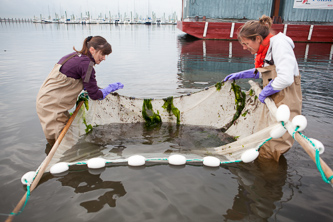Over $11 Million Awarded to Science and Resilience Institute at Jamaica Bay
Aug. 6, 2014

Brooklyn College researchers at Jamaica Bay.
The Science and Resilience Institute at Jamaica Bay (SRI@JB), currently hosted by lead institution Brooklyn College, has been awarded $7.7 million from New York State and $3.6 million from the Department of the Interior’s Hurricane Sandy Mitigation Funding. The funds will support research on environmental resilience in urban coastal ecosystems at SRI@JB, a consortium led by The City University of New York (CUNY) that hosts visiting scientists, provides lab facilities for students and researchers, and convenes events to share and disseminate their findings.
Jamaica Bay—an 18,000-acre area located at the southern edge of New York City, and bordered by Brooklyn, Queens, and Nassau County—is a collection of meadowlands and waterways whose soil erosion has in recent years caused flooding of surrounding populated areas. The protection and revitalization of the bay is considered essential, not only because it is home to over 325 species of birds, 100 species of fish, 50 species of butterflies, two freshwater ponds, and a wide variety of flora, but also because the entire ecosystem serves as a barrier against the forces of wind and tide, helping to minimize flooding and filter out pollutants.
"We are excited about the opportunities for Brooklyn College faculty, students, and SRI@JB researchers," said Professor John Marra, director of the college’s Aquatic Research and Environmental Assessment Center (AREAC). "With the funds from New York State, we can revitalize AREAC to support research efforts of SRI@JB. For example, AREAC is optimally suited to replicate, in the laboratory, environments found in the bay for controlled experimentation." Together with Kingsborough Community College, a new research vessel will be designed and built allowing much needed access to the open waters of the Bay.
The funded project work will begin immediately. SRI@JB will conduct research that ranges from studying the water quality within Jamaica Bay and the health and resilience of its salt marshes to monitoring and evaluating ecosystem restoration efforts. It will also allow SRI@JB to help evaluate community-generated strategies, catalog the environmental history of Jamaica Bay, and develop the groundwork for long-term research.
"This funding will enable the creation of a modern monitoring network of high tech sensors," said Brett Branco, assistant professor in the Department of Earth and Environmental Sciences. "This will provide us with a better understanding of the bay’s dynamics and how it responds to human impact and natural disturbances."
In 2011, the New York City Mayor Michael Bloomberg and Secretary of the Interior Ken Salazar initiated a partnership designed to restore and revitalize Jamaica Bay and Rockaway Park and develop a joint vision for a new "great urban park." As part of this effort, a consortium led by CUNY was selected to lead a new Science and Resilience Institute at Jamaica Bay. In 2014, a CUNY consortium lead by Brooklyn College was awarded a competitive grant through the State’s CUNY 20/20 initiative, which brought an additional $7.7 million to the project.
SRI@JB is a joint initiative among the National Park Service, the City of New York, and a consortium of top-tier research institutions, including Columbia University, Cornell University, the Institute of Marine and Coastal Sciences at Rutgers University, NASA Goddard Institute for Space Studies, New York Sea Grant, Stevens Institute of Technology, Stony Brook University, (SUNY), and the Wildlife Conservation Society. Plans are underway to construct a new facility located on Jamaica Bay.
Brooklyn College has initiated a search for a director of SRI@JB, who will join the college as a full-time faculty member later this year. The institute is expected to become a regionally, nationally, and internationally recognized source for research on resilience analysis and practice in a highly urbanized environment. It will coordinate and lead resilience research, and contribute toward science-based policy to ensure the sound management of the bay. These policies will in turn serve as a model for cities around the world.






